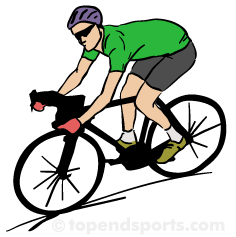This is a test of anaerobic fitness. The 40m cycle sprint test is part of the eTID Talent Identification Testing Program for sprint cycling, and their protocol is listed here. There are actually two tests, the standing start 40m speed test, and flying 40m speed test. See also the 2km cycling time trial which is part of the same protocol.
test purpose: This test measures anaerobic fitness and leg muscles explosive power, as well as cycling speed.
equipment required: An appropriate 80 meter route (e.g. a velodrome, running track, parking
lot or road), bicycle, stopwatch, measuring tape, witches hats (or marking tape).
pre-test: Explain the test procedures to the subject. Perform screening of health risks and obtain informed consent. Prepare forms and record basic information such as age, height, body weight, gender. Record the test conditions, such as the weather, wind and track surface, particularly if testing is performed outside. Record details of the bike used, and set up the seat and handlebars to suit the athlete. See more details of pre-test procedures.

procedure: Mark out a 80m distance and place witches hats/marking tape at 0m, 40m and 80m. Place two witches hats approximately 5m after the finish line (85m mark).
- Standing start: The subject should start with their feet on the pedals, the front bike wheel at the 40m marker, with someone holding the subject and bike up. The subject is to ride as fast as possible to the final witches hat (approx. 45m). The subject starts after the command "one, two, three, go!” with the tester also starting stopwatch on the signal ‘go’. The tester stops the stopwatch when the subject’s front wheel crosses the finish line.
- Flying start: The subject is to use the first 40m as a lead, in an attempt to reach maximum speed for the final 40m. Timing is started when the subject crosses the start line (at the 40m mark) and stopped when the subject crosses the finish line (80m).
scoring: The fastest time for both the standing start and flying start should be recorded to the
nearest second.
advantages: this test is a very cheap and simple test to perform.
disadvantages: performance on this test can be affected greatly by motivation.
comments: The subject should be instructed to ride right through to the witches hats to ensure they don’t decelerate before they reach the finish line and therefore increase their total time.
The Test in Action
- The 40m cycle sprint test is part of the eTID Talent Identification Testing Program for sprint cycling
Similar Tests
- 10 & 30 second tri-level cycle test of leg power.
- Wingate Cycle Test — a cycle test of anaerobic leg power, maximal effort over 30 seconds.
- Cycling Repeat Sprint Test — a cycle test of anaerobic capacity, involving 5 x 6 second efforts every 30 seconds.
Related Pages
- Fitness tests for cyclists
- Cycling Fitness Tests, assessments involving cycling exercise
- About the eTID Talent Identification Testing Program.
- ETID Fitness Testing for Cycling
- Comparison of Cycle Ergometers
- General information about Sprint or Speed Testing
- Other anaerobic tests and about anaerobic testing


 Current Events
Current Events